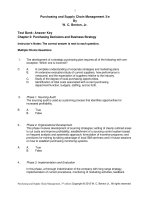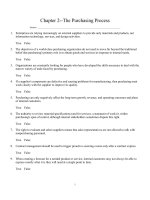Lecture Purchasing and supply chain management (3rd/e): Chapter 13 - W. C. Benton
Bạn đang xem bản rút gọn của tài liệu. Xem và tải ngay bản đầy đủ của tài liệu tại đây (672.23 KB, 18 trang )
Chapter 13:
Price Determination
Purchasing and Supply Chain Management
3rd edition
Purchasing and Supply Chain Management, 3rd edition, Copyright © 2013, W. C. Benton Jr., All rights reserved.
Purchasing and Supply Chain Management 3rd edition, Copyright 2013 W.
1
Contents
•
The Purchasing Decision and Purchasing Professional
•
Price
•
•
Discounts
•
Pricing Methods
Cost
•
•
•
Learning Curves
Cost Structure Analysis
•
Terminology
•
The Breakeven Analysis
The Negotiation Process
2
Purchasing and Supply Chain Management, 3rd edition, Copyright © 2013, W. C. Benton Jr., All rights reserved.
Price of a Product or Service
•
•
Usually based on a variation of cost and cover
•
Production
•
Promotion
•
Distribution
•
A reasonable profit
Purchasing professional
•
Responsible for determining price
•
Must be aware of market conditions and prices associated with
quality levels
3
Must become an expert in the item being purchased
Purchasing and Supply Chain Management, 3rd edition, Copyright © 2013, W. C. Benton Jr., All rights reserved.
•
Price Setting Strategies (Economics)
•
The formula for setting prices
•
Differ between firm and industry
•
•
General approaches:
•
Costbased approach
•
Market approach
•
•
E.g., chemical industry and computer industry
The most popular approach for competitive environments
Target pricing
4
Purchasing and Supply Chain Management, 3rd edition, Copyright © 2013, W. C. Benton Jr., All rights reserved.
•
The price set by the buying firm that fits its competitive cost
Price Setting Strategies (Psychological)
•
Power
•
•
The major psychological influence in a buyer–supplier
relationship
A powerful buyer:
•
Could force a supplier to eliminate its overhead from the ultimate
price
•
Could drive the supplier out of business and reduce competition
in the supply market
5
Purchasing and Supply Chain Management, 3rd edition, Copyright © 2013, W. C. Benton Jr., All rights reserved.
General Sources of Price Information
1.
Published price lists
2.
Quotations
3.
Other buyers in the market
4.
Trade journals
5.
Negotiations
6.
Competitive
7.
Bidding
8.
Distribution
6
Purchasing and Supply Chain Management, 3rd edition, Copyright © 2013, W. C. Benton Jr., All rights reserved.
Discounts
•
Popular discount types:
•
Cash Discounts
•
When payments for goods and services are promptly remitted
•
Example: Cash discount of 3/10, net 30
•
•
Trade Discounts
•
•
If the buyer pays within 10 days of the shipment date of the invoice, it
may deduct a 3 percent from the invoice price
Buying firm splits the middlemen profit margin and buys directly
Quantity Discounts
•
Granted to the buyer for buying larger quantities
•
The Robinson–Patman Act
7
Purchasing and Supply Chain Management, 3rd edition, Copyright © 2013, W. C. Benton Jr., All rights reserved.
Pricing Methods (cont.)
•
•
Competitive bidding
•
Must begin with an assessment of the suppliers’ pricing strategies
•
Takes from four to eight weeks for most industrial firms
Conditions for competitive bidding:
1.
The dollar value of the spend must be large enough to justify
the expense of the competitive bidding process
2.
The specifications of the product or service must be precise
enough for both the buying and selling firms to accurately
estimate
3.
There are enough selling firms in the market
8
Purchasing and Supply Chain Management, 3rd edition, Copyright © 2013, W. C. Benton Jr., All rights reserved.
Competitive Bidding
•
•
A probabilistic bidding strategy
•
Buying strategy for competitive bidding process
•
Based on the profitmaximization strategy
•
Assumes that the buying firm will select the firm with the lowest
bid
•
Used by the most wellmanaged selling firms that use the
competitive bidding
An estimate of a reasonable bid amount
•
Based on:
•
The dollar value of previous bids
9
Purchasing and Supply Chain Management, 3rd edition, Copyright © 2013, W. C. Benton Jr., All rights reserved.
Costs
•
Cost components:
•
•
Direct costs
•
Costs are not incurred if the unit is not produced
•
E.g., direct labor, direct materials costs
Indirect costs
•
•
Non–manufacturingrelated costs
E.g., insurance, managerial salaries, property taxes, and
depreciation expenses
10
Purchasing and Supply Chain Management, 3rd edition, Copyright © 2013, W. C. Benton Jr., All rights reserved.
Learning Curves
•
•
A method for predicting the efficiencies of
increasing outputs
Reflects a systematic improvement of labor per
unit as a function of cumulative units produced
80 % learning
curve
11
Purchasing and Supply Chain Management, 3rd edition, Copyright © 2013, W. C. Benton Jr., All rights reserved.
Learning Curves (cont.)
•
•
Characteristics:
•
Exponential
•
A constant percentage reduction of labor as a function of
cumulative units produced
•
Especially important in various assembly operations
Uses:
•
Cost estimating
•
Pricing
•
Negotiating contracts
12
Purchasing and Supply Chain Management, 3rd edition, Copyright © 2013, W. C. Benton Jr., All rights reserved.
Cost Structure Terminology
•
Definitions:
•
Gross margin
•
•
•
Includes overhead and profit
Net margin
•
•
The difference between the price of the job and the costs to build
a job
Refers to profit alone
Markup
•
A job costs times a factor that covers direct costs, overhead
cost, and profit
Gross margin and markup are not the same13
Purchasing and Supply Chain Management, 3rd edition, Copyright © 2013, W. C. Benton Jr., All rights reserved.
•
Margin versus Markup Conversion Chart
14
Purchasing and Supply Chain Management, 3rd edition, Copyright © 2013, W. C. Benton Jr., All rights reserved.
Contents
•
•
Cost Structure Analysis
•
Terminology
•
The Breakeven Analysis
The Negotiation Process
•
Price/Cost Analysis
15
Purchasing and Supply Chain Management, 3rd edition, Copyright © 2013, W. C. Benton Jr., All rights reserved.
The Negotiation Process
•
The negotiation process is a learned behavior
•
•
•
Winwin for both buyer and the seller
Each and every aspect of a business transaction is
negotiable
•
There exists a possibility for negotiation of pegged costs
•
Use price/cost analysis
Excellent candidates for negotiations
•
Direct labor, overhead, and administrative costs
16
Purchasing and Supply Chain Management, 3rd edition, Copyright © 2013, W. C. Benton Jr., All rights reserved.
Price/Cost Analysis
•
A buying firm must:
•
•
Consider the price variation in order to understand:
•
Various design specifications
•
Associated costs
Obtain reasonable cost comparisons based on:
•
Historical data of similar equipment
•
Experience with conditions in the specific industry
17
Purchasing and Supply Chain Management, 3rd edition, Copyright © 2013, W. C. Benton Jr., All rights reserved.
Questions?
18
Purchasing and Supply Chain Management, 3rd edition, Copyright © 2013, W. C. Benton Jr., All rights reserved.









